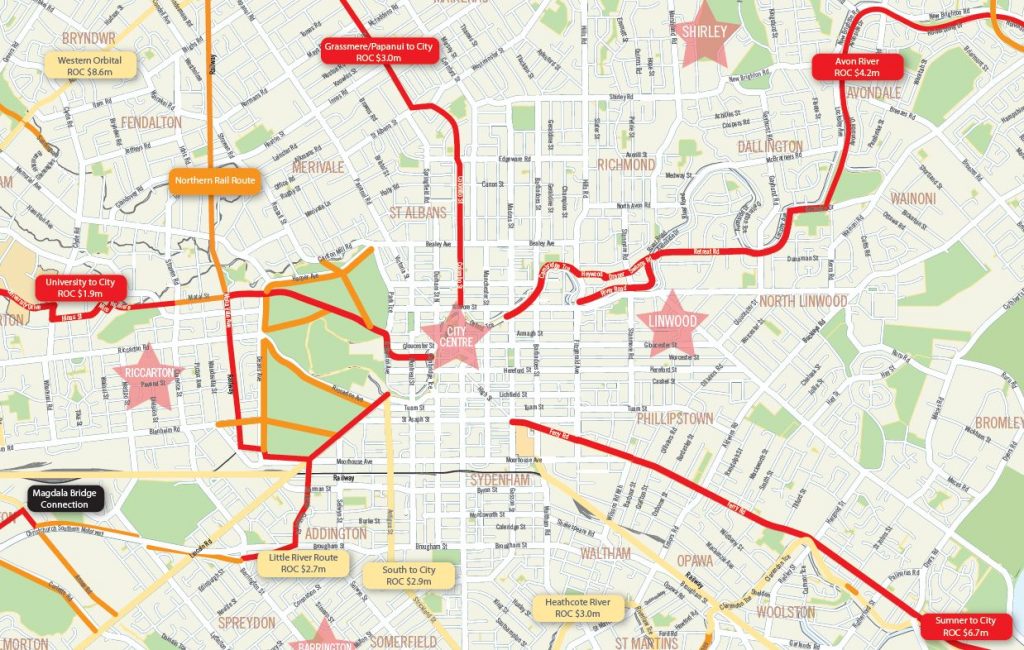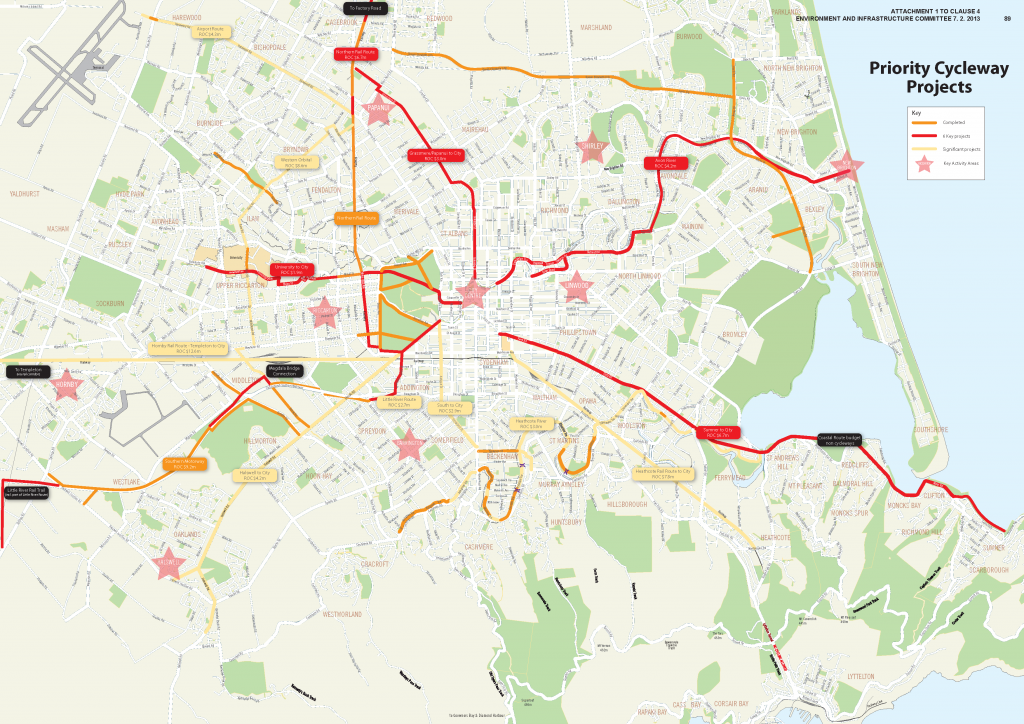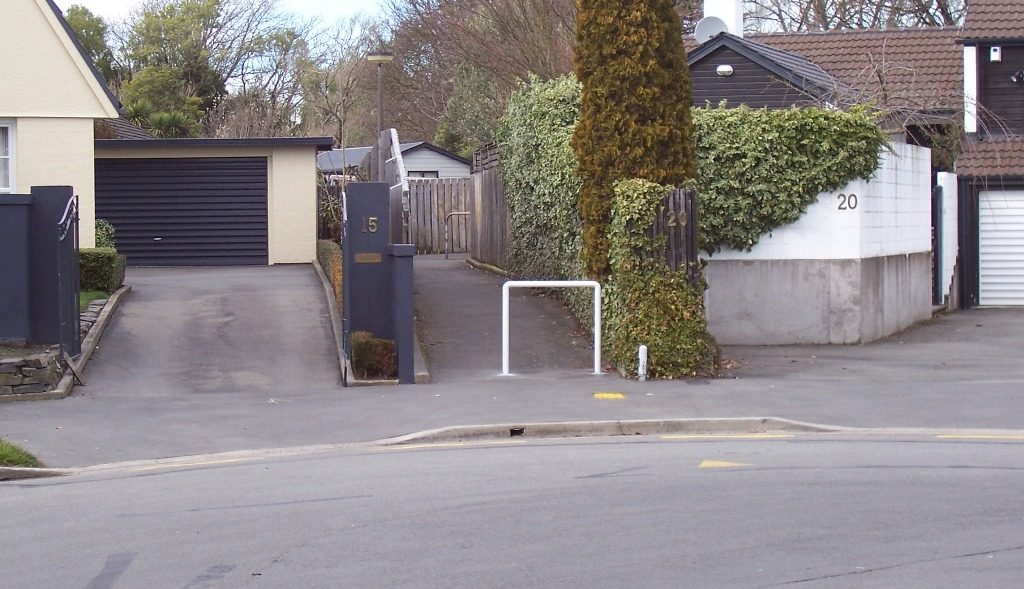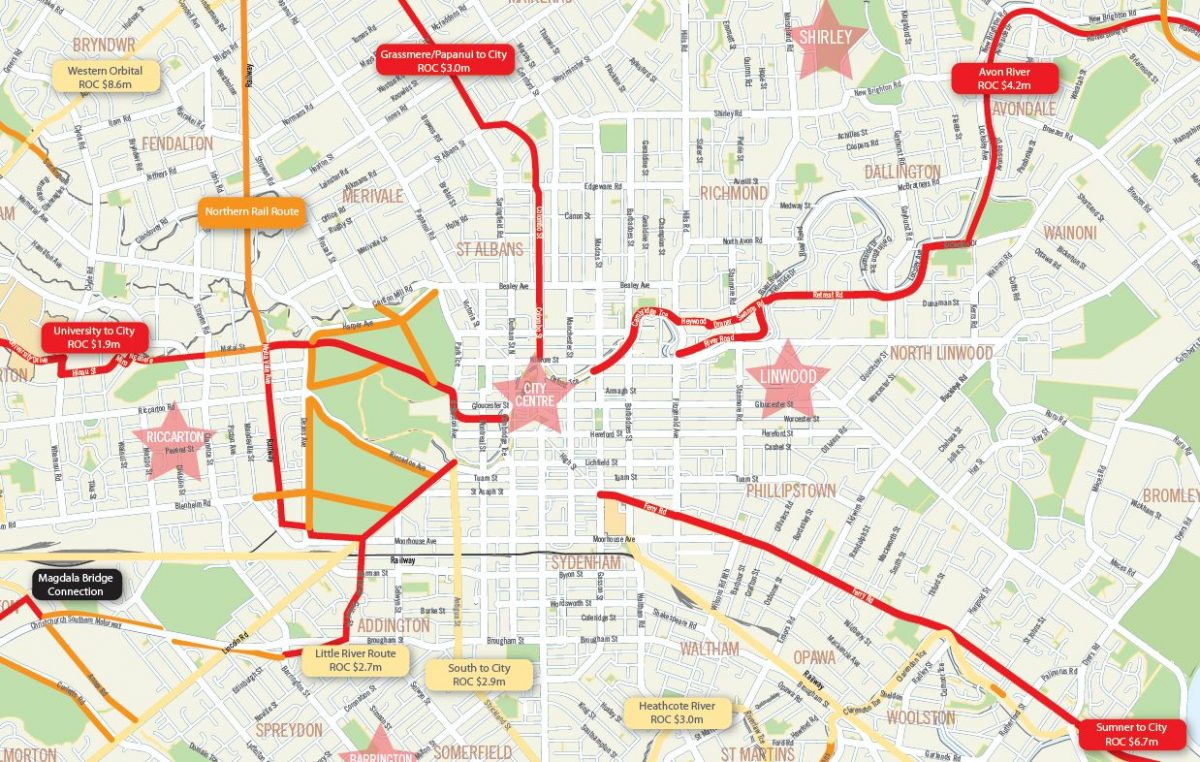Now we’re starting to get to the details… some potential cycleway routes that might be funded in coming years have been identified and presented to City Council. You might recall that late last year, following submissions on the Chch Strategic Transport Plan, Council asked its Environment & Infrastructure Committee to “identify four to five key cycling projects that can be brought forward for early completion in Council’s next Long Term Plan (2013-22)”. Staff have duly gone away and investigated options and these were presented to the E&I Committee last Thursday, as reported in The Press (full agenda note is here; note this a 20MB PDF download).

Thirteen routes were identified for consideration around the city; the intention is that these would all be built to a high standard for “all ages and abilities”, comprising a mixture of off-road pathways, separated bikeways, and quiet street links (aka “neighbourhood greenways”). Collectively all 13 would cost a shade under $70million. However they identified six costing $25m as their top priorities.
Looking at the routes identified, most of them are fairly logical and many were listed even long before the earthquakes changed the game. There are clear synergies with initiatives already underway in the east to develop pathways along the Avon and out to Sumner. Some, like the University route, already had investigation and design work done prior to the quakes, so should be easier to get off the ground. And in some cases, like the northern Railway cycleway, sections already exist and it’s just a case of extending it further and upgrading some crossings to attract a wider catchment.

Spokes Canterbury has also been doing some work on identifying a city-wide strategic network (hopefully more on that in the near future) and I presented some thoughts on this to the Committee last Thursday. Although Spokes’ work greatly mirrors staff thinking around cycle networks, there were probably a couple of areas worth further consideration:
- Out to the east, there is a big gap in the Linwood/Aranui area. As well as connecting these communities, providing routes through here might also provide more direct or pleasant options towards New Brighton and Ferrymead than the Avon River corridor (a bit circuitous) or Ferry Road (probably still going to be a busy environment and not easy to provide cycleways).
- Towards the southwest, the Lincoln/Halswell Road corridor will be difficult in places to provide pleasant options. Given that there is still undeveloped land between Hoon Hay and Halswell, there seems an opportunity to create a corridor along a more quiet route (and arguably more directly through communities).
Another great initiative proposed for spending in the first few years is a “targeted improvements” programme of ~$0.5m. The idea of this is to identify “quick wins” whereby a little bit of work could improve an existing cycle route. This could mean simple things like kerb ramps, barrier removals, crossing treatments, pinch-point widening, short pathways, cycle lane separators, removing a pesky parking space, signs & markings, whatever. I suspect that fixing a lot of these would generate as much goodwill as a couple of new flagship cycleways.

While the Committee seemed very supportive in principle of the plans, the money required to construct these made them rather nervous. This seems silly given the sheer magnitude of the overall transport spend expected here in the next decade, and the relative benefits of cycleways, but that’s another post. To their credit they did decide to recommend to Council giving the go-ahead to the University and Grassmere (St Albans / Papanui) routes in the next three years and also to support spending $1million on the “quick wins” initiative. Ongoing work is also likely to investigate further options for the southwest, and to link in with the Avon River and Coastal Pathway projects in the city and east.
So what would YOUR priority routes for safe cycling around Christchurch be?


This is starting to get exciting and may the momentum continue . Thanks for this post , it does show that despite the frustrations of cycling at present , that there is work going on behind the scenes and that others in a position to make a difference are working to do just that . As a St Albans resident , clearly the Grassmere route would be my priority. By linking it to the rail corridor a whole range of safe options would then be accessible. One suggestion for quick fix improvements would be the Carlton Mill intersection with Bealey Ave and Park Terrace to get in to and out of Hagley Park . Short of getting off and using several sets of pedestrian lights it is quite a nightmare for actual cycling . Like our bus service now , has thought been given to identifying community hubs which would benefit from work to assist residents to cycle to their local shopping centre ? . I know areas such as Edgeware and New Brighton have streetscape plans in the pipeline and wondered if these could be integrated with a “local” cycle safe network to encourage those short trips on a bike .
N end of Strickland St, junction with Brougham Ave. A few plastic sticks and the cars stick to their lane. Epitome of a Quick Win, thanks CCC : )
Quick win:
1. Cut down kerb on north end of Latimer Square.
2. Easier access (cut down kerbs) to get on to east side of Hagley Park, e.g. at end of Peterborough St
3. Make cycle light phase coming off Hagley Park into Kilmarnock St a bit longer, esp. at peak times.
4. Seal down sides of road into Riccarton Bush from Kahu Road alongside speed humps so cyclists don’t have to go over humps.
5. Shared pedestrian/cyclists paths near and in Hagley Park – completely separate – i.e. put in paths alongside or separate onto existing paths. Currently shared paths don’t work well for either cyclists or pedestrians.
These 6 routes will make a difference and will encourage people to get on their bikes more, no doubt. But the 13 routes would have been a real game-changer and that is basically what we were promised. Ditch the convention center and the covered stadium and spend the money on creating a livable city that includes a safe and complete cycling network.
Cycling infrastructure has been getting less than 1% of the transport budget for decades. CCC’s negligence has created a deep debt of undelivered cycle improvements. With nearly 10% of commuters on bicycles its time cycling receive both its current 10% share plus a lot more to make up for past neglect. The community has made clear our desires through Share an Idea and submissions. Its time for major culture change at CCC.